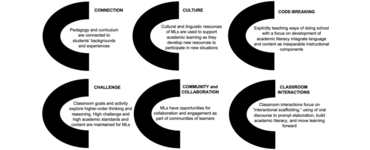The cognitive processes involved in reading comprehension depend on accurate decoding. This paper explains how visualization improves both comprehension and decoding, and it provides a variety of activities that encourage students of all ages to visualize both the forms and meanings of words.
Key words: reading comprehension, decoding, visualization, interactive
Competent readers make movies when they read, picturing the events, characters, and information in their minds (Bell, 2007). Although the clarity and detail of the pictures may vary, a good reader can see a fish when reading “f-i-s-h,” and can imagine the scene of Harry Potter’s first broom ride when he chased after Neville’s Remembrall. If readers cannot make movies as they read, their understanding and memory of the text can be severely compromised (Bell, 2007).
Visualizing what we read is important not only for comprehension, but also for decoding because the critical first steps in learning to read involve phonemic awareness and linking the visual images of letters to their sounds. Words are stored by sound in long term memory, yet recognized visually when reading, so both the sounds and the letters of a word are needed to recognize written words (Farrell & Cushen White, 2018; Seidenberg, 2017). Can you close your eyes and picture the letters in “fish”? Readers who cannot picture the letters in words may struggle with word recognition and spelling (Bell, 2001, p. 29).
For beginning or struggling readers of any age, then, training in how to visualize the spelling and meaning of words can be enormously beneficial. After exploring the cognitive processes behind the roles of visualization in decoding and comprehension, this paper describes strategies for helping students visualize what they read.
Cognitive Processes
Decoding
Learning to read begins with phonemic awareness and decoding, which entail using the pronunciation of a word to link sounds to letters (Kilpatrick, 2015, pp. 253-269). Seidenberg (2017, p. 119-120) asserts that the “initial hurdle” of decoding involves understanding how letters in written language represent phonemes (sounds) in spoken language. Phonemic awareness entails taking spoken words that are uttered as a series of connected phonemes and teasing out the individual sounds. Then these sounds are associated with arbitrary written symbols, or letters. Because the decoding task is cross modal, linking auditory and visual information, it becomes even more difficult. Yet the links between phonemes and letters must become automatic—quickly and effortlessly accessed—in order for a reader to comprehend a text, in large part because of the limits of working memory.
Working memory only lasts 20 seconds and holds only about five to seven pieces of information in adults (Goldstein, 2015, pp. 127-129). Working memory is not so much about storing information as it is about using information (Baddeley, 2012). For example, working memory allows a listener to process what someone says, holding the first part of an utterance in mind, combining it with the next part of the utterance, and making sense of the entire statement. Similarly, readers use working memory to parse what they read, connecting information in the first part of a sentence or paragraph to the next part.
For readers who are not fluent, decoding becomes a bottleneck that reduces or even eliminates comprehension. This bottleneck in processing can be traced to many sources for second language (L2) readers, including slow word recognition, trouble with syntax, and pronunciation (Koda, 2007; Nassaji, 2007; Shiotsu & Weir, 2007). For young readers, whether they are L2 learners or not, simply recognizing letters and linking them to sounds can pose such a hurdle that the beginning of a CVC word is lost to working memory before the final consonant is ever reached. Furthermore, automatic decoding allows words to be identified as chunks of information, so that “fish” counts as only one item in working memory rather than four separate letters or three phonemes. Because the working memory capacity of children is even more limited than adults, with 3-4 items for elementary students (Paulson, 2018), automatic decoding is essential for young readers.
Comprehension
For comprehension of longer texts, which is to say, anything that exceeds the 20-second time limit of working memory, readers need to convert the words to semantics, or meaning, that can be stored in long-term memory. This conversion is necessary because long-term memory stores most information semantically, based on meaning and associations (Goldstein, 2015, p. 160). Visualization facilitates this conversion, allowing mental images to replace the individual words that created the scenes. In other words, although I could not quote J. K. Rowlings’ exact description of Harry Potter’s first broom flight, I could provide a fairly detailed description of what happened based on my mental image of the event.
Given that comprehending a text involves many cognitive processes which essentially require a back-and-forth interplay between working memory and long-term memory, making a movie as one reads enables ongoing comprehension. Working memory busily processes the incoming visual words, retrieving their phonemic representations and semantics from long-term memory. When this process is automatic, the meanings of individual words are easily combined in phrases and paragraphs, whose images are stored in long-term memory for later access as the longer text unfolds. If the process is not automatic, readers may be unable to either retrieve word meanings from long-term memory, or to make images of phrases that can be encoded in long-term memory. As Bell (2007) points out, readers who fail to create a picture in their mind of what they are reading will end up not understanding or remembering a text they have just labored over.
Visualization strategies
Many strategies that help students visualize meaning and spelling echo the best practices English Learner (EL) teachers already use to engage students. However, by intentionally linking interactive techniques to visualization, students not only benefit from engaging, multimodal activities, but they also gain specific skills that equip them to become stronger readers and more proficient spellers. Some strategies described in this paper target meaning:
A. drawing
B. using props
C. acting.
These meaning-based strategies were inspired by Bell’s (2007) work on visualizing and verbalizing, but instead of requiring students to verbally describe their mental images as Bell does, these strategies encourage nonverbal communication. Visualization techniques that target spelling and decoding (adapted from Bell, 2001 and Slingerland, 1971) include:
D. air writing
E. backwards spelling bee.
All of these visualization strategies are outlined below, with tips for implementation. These strategies can be used with students of all ages, and most can be modified for small or large groups, or for online learning.
Strategies that target meaning
The first step in each of the meaning-based strategies is for students to read a word, sentence, or passage. Keep in mind that the way that students read the material can vary, depending on how challenging it is for them. For example, they may read independently and silently, or they may read aloud with the support of choral reading or partner work. Even in distance learning, students can read aloud. In one-on-one online contexts, the student could read aloud for the teacher; in a synchronous group meeting, volunteers could read the text aloud. For asynchronous lessons, a teacher can model reading aloud to a stuffed animal, a pet, or a family member, and encourage students to do the same. Regardless of how students read the material, immediately following their reading, they use a visualization strategy to practice seeing in their mind what they just read.
A. Steps for drawing:
1. Students read a word, sentence, or passage. As noted above, give students as much or little support as needed for this step.
a. Tip: Students who struggle may need the support of choral reading, help sounding out words, targeted pronunciation work, or comprehension checks.
b. Tip: More skilled readers may be able to read silently and independently, or aloud with a partner.
2. On a separate piece of paper, students sketch a picture of what they read.
a. Tip: It often helps to set a time limit of 2-3 minutes so that students do not get bogged down in trying to create elaborate drawings.
b. Variation: Students can draw on a whiteboard, which facilitates several rounds of reading and drawing.
c. Variation: The teacher can create a worksheet with a box next to each word or passage for students to draw what they visualize.
d. Variation: The teacher can create worksheets with pictures that students match or cut and glue. The Explode the Code series (Hall & Price, 2016, available in hard copy or online) also has exercises for matching words and pictures for a range of reading levels.
3. Students share their pictures. They can share quickly by holding up their pictures so the teacher and other students can see what they drew, but it can be helpful to have some or all students briefly explain what their picture shows and receive feedback.
a. Tip: The immediate feedback should target important details that students did or did not include, such as, “I see Julio drew the cat sitting on the mat instead of standing. That’s great because the sentence said that the cat was sitting.”
b. Variation: Students could do a gallery walk, partner share, or other interactive strategies, particularly if they have read a longer passage.
c. Variations for online lessons: Synchronous video lessons might allow students to hold up their pictures to their camera for others to see. With Flipgrid, students could create a brief video showing and explaining their work. Other applications, such as Padlet, would allow students to take a picture of their work and upload it with a brief written comment.
B. Steps for using props (see Figure 1):
1. Students read a sentence or passage. Give students as much or little support as they need; for differentiation ideas for this step, see the “Tips” in A. 1. above.
a. Tip: This technique works well for longer passages that students re-read with a partner as they use the props. In this case, the initial reading could be independent or choral.
2. Students receive, choose, or create props to use.
a. Tip: Depending on your goals for the lesson, this step can take as little time as distributing materials, or it can be a multi-day project for creating materials.
b. Tip: Before distributing materials, model how the props might be used to show meaning. Modeling is especially important the first few times this activity is used.
c. Variation: Props might include figurines, puppets, toys, and math or science manipulatives.
d. Variation: Props that students create could be made with playdough, paper, felt, or objects such as rocks, sticks, and cardboard boxes.
3. Students use props to show the meaning of the sentence or passage.
a. Tip: If students work with partners, the stronger reader can read the passage aloud while the weaker reader shows the meaning using the props, and then the students switch roles.
b. Tip: With non-fiction texts, partners can work together to decide how to show the meaning of the passage. Then some or all groups would demonstrate their work to the class.
c. Variation: To encourage students to demonstrate deeper understanding, ask students to analyze and evaluate, rather than create. The teacher or a volunteer can use props to show the meaning of a passage, sometimes deliberately making mistakes. The rest of the class gives a thumbs up or down, or some other response, to indicate if the demonstration matches the passage.
d. Variations for online lessons: For synchronous lessons, variation C above would work well (having the teacher or a volunteer use props while others give a thumbs up or down). For asynchronous lessons, Flipgrid or other video tools would allow students to submit their own puppet shows.

C. Steps for acting:
1. Students read a sentence or passage. Give students as much or little support as they need; for differentiation ideas for this step, see the “Tips” in A. 1. above.
a. Tip: Like using props, this technique works well for longer passages that students re-read in small groups.
b. Variation: Instead of having all students act out the passage, skip steps 2 and 3 below and have just the teacher and perhaps some volunteers act it out. This variation is useful when first introducing the activity to a class, or if students are not confident because of limited English skills or because a collaborative class culture is still being built.
2. Students rehearse the scene. Model how to act out a scene before asking students to rehearse and act, particularly the first few times this activity is used. Depending on students’ needs, the teacher can model the entire scene, a portion of it, or a different scene from the one students will perform.
a. Tip: When modeling how to act out the meaning, a student who is a strong reader can narrate while the teacher acts.
b. Tip: Having some simple props makes the activity more fun.
c. Tip: Introduce or assign roles. For example, a fiction text about a dog and boy could have three roles: narrator, dog, boy. A nonfiction text about the water cycle could have two roles: narrator, water. By making the roles clear, groups can focus more quickly on rehearsing.
d. Variation: If the passage is short, students might not need to rehearse, but can go straight to performing their assigned sentence. In this case, each group could be assigned a different sentence. The class could read all sentences at the beginning of the activity, then groups perform them in turn. Alternatively, the class could read a sentence together, one group performs it, then the class would read the next sentence, a different group performs it, and so on.
3. Students perform the scene.
a. Tip: To save time, only one or two groups perform for the whole class. The groups can be chosen as the teacher circulates among groups, and the teacher might let the selected groups know that they will be performing.
b. Variation: Although it is often helpful to have a narrator who reads the text while others act out the meaning, omitting a narrator may be appropriate for longer texts.
c. Variation: Groups are paired to perform for each other. In this case, the teacher gives a signal, such as ringing a bell, when it is time for the second group in a pair to perform.
d. Variations for online lessons: For asynchronous lessons, students can be assigned different sentences or texts to perform, without reading the text during their performance. Using a platform like Flipgrid, students watch each others’ videos and post comments to guess which texts their classmates performed. Synchronous lessons could include a similar game, either using the comment box or offering guesses aloud after each performance.
Strategies that target spelling and decoding
Visualizing the letters in words can be as fun as visualizing meaning through drawing and puppet shows. Because readers need to visualize both the letters and the meanings of words, visualization strategies that target spelling can and should be used in conjunction with strategies that target meaning. Depending on students’ needs, it may make sense to introduce spelling and decoding strategies first. A group of native English-speaking kindergarteners, for example, probably needs more work initially with visualizing letters and linking them to sounds in words. In contrast, a group of WIDA Level 2 EL eighth graders who are literate in their home language may benefit most from practice picturing the meaning of what they read, and only later working on visualizing the spelling of words.
The visualization strategies below can be quick exercises at the beginning of a lesson, or they can be longer activities that are the focus of a lesson. In either case, pacing is key to giving students enough time to think while at the same time maintaining a good energy level.
D. Steps for air writing (adapted from Bell, 2001; Slingerland, 1971; see linked website Sight Words, 2020):
1. Introduce a word visually, saying the word aloud and encouraging students to notice all the letters.
a. Tip: Students chorally repeat the word and tap out the phonemes as you point to the corresponding letters. As needed, notice the number of letters and syllables, prefixes and suffixes, stress, and applicable spelling rules.
b. Variation: Words can be written on a board, shown as flash cards, or read in a book or worksheet.
c. Variation: When working on sounding out words or applying spelling rules, omit showing the word, or show it after students have printed it in the air so they can check their accuracy.
2. Students use one finger and a straight arm to write the word in the air.
a. Tip: The letters need to be about the size a teacher would write on a whiteboard, and written carefully in a straight line in front of the student. Sloppy air writing or overlapping letters minimizes the benefit of visualizing and feeling the letters.
b. Tip: Students can imagine they are writing on a whiteboard, even choosing the color of dry erase marker they are using.
c. Variation: Write the word, using one finger, on a table or the floor instead of in the air.
3. Students close their eyes and visualize the word they wrote.
a. Tip: Erase or remove the word you showed in step 1.
b. Tip: Ask students what color their word is, if they can see specific letters, what the last letter is, or other probing questions to help them really “look” at the word.
c. Variation: Students keep their eyes open and look at the imaginary whiteboard in front of them, or the table or floor where they wrote the word, and visualize the word.
d. Variation for online lessons: Air writing could be done in a synchronous lesson if the teacher can see students; it would work best in lessons with 1-3 students.
E. Steps for backwards spelling bee (adapted from Bell, 2001):
1. Show students a word on a flashcard or whiteboard; students read the word aloud. Then, hide or erase the word.
a. Variation: Instead of reading the word chorally, students may read it silently, or individual students can be called on to read it.
b. Variation: To make the activity more game-like, familiar words can be flashed to students for just a second or two.
c. Variation: Cover one letter at a time instead of the whole word to help students gain confidence.
2. Outloud, one student spells the word forwards.
a. Tip: To keep a fun fast pace, encourage students to spell quickly, or give them a time limit.
b. Tip: If a student cannot spell the word or misspells it, go to the next student. If several students in a row cannot spell the word, either ask for a volunteer to spell it, or show the word again and go to the next student in line.
c. Variation: For the first practice session with a set of words, all students write the word on a whiteboard, check it when the teacher shows the word again, then erase it. This variation can also be used in subsequent sessions to make the task easier and less competitive.
d. Variation: To make the task easier, one student writes the word on a whiteboard, shows it, then erases it.
e. Variation: To make the task harder, skip this step and go straight to step 3, spelling the word backwards.
3. Outloud, another student spells the word backwards. Confirm the correct spelling enthusiastically.
a. Tip: Encourage students to go slowly and take their time. The cognitive load of spelling backwards is high, requiring visualization as the speller toggles between working memory and long-term memory.
b. Tip: As in step 2, if a student cannot successfully spell the word backwards, go to the next student, ask for a volunteer, or show the word again and go to the next student.
c. Tip: Unlike writing the word forwards, writing backwards can be confusing and unhelpful, so I avoid writing on this step. Instead, students can point to the invisible letters in the air, going backwards.
d. Variation: Ask the rest of the class to say whether the word was spelled correctly; if they are uncertain or disagree, have the speller spell the word again so the class has a second chance to evaluate the spelling.
e. Variation for online lessons: The game-like aspect of this activity works well in synchronous lessons, whether with one student or a group. To avoid students cheating by writing down the word, student videos should be visible.
Strategies and learning
When choosing visualization strategies, teachers should consider not just the type of visualization that a strategy targets, whether meaning or spelling, but how visualization fits in the goals of a lesson or unit. To encourage peer interaction, using props and acting emphasize partner and group work, but drawing can also incorporate interactive sharing at the end of the activity. For in-person or online teaching, drawing lends itself well to assignments that are submitted, but using props and acting could be assigned if students can use video tools such as Flipgrid. Online lessons that incorporate air writing can be delivered as pre-recorded videos or as synchronous video meetings, but in-person work on air writing may make it easier to give feedback to students and make sure they are practicing effectively. Whatever way a teacher decides to use visualization activities, it is fairly simple to adapt them to different settings and lessons, so these research-based strategies are both versatile and fun.
Recommended resources
- Explode the Code series, available online (https://www.explodethecode.com/) or in print (e.g., https://www.rainbowresource.com/category/822/Explode-the-Code.html): This phonics-based program includes many exercises using pictures that encourage visualization of meaning.
- Lindamood-Bell programs (https://lindamoodbell.com/our-approach-learning-centers#OurPrograms): Workshops, instructional guides, and workbooks provide a wealth of resources for reading and visualizing, particularly the Seeing Stars and Visualizing & Verbalizing programs.
- Reading Matters website (https://seidenbergreading.net/): As a companion to his very readable book Language at the Speed of Sight: How We Read, Why so Many Can’t, and What Can Be Done About It (Seidenberg, 2016), Seidenberg’s website includes blog posts, links to references cited in the book, and other resources such as links to talks and videos.
References
Baddeley, A. (2012). Working memory: Theories, models, and controversies. The Annual Review of Psychology, 63, 1–29. https://doi.org/10.1146/annurev-psych-120710-100422
Bell, N. (2001). Seeing stars: Symbol imagery for phonemic awareness, sight words and spelling. Gander Educational Publishing.
Bell, N. (2007). Visualizing and verbalizing: For language comprehension and thinking (2nd ed.). Gander Educational Publishing.
Farrell, M. L., & Cushen White, N. (2018). Structured literacy instruction. In J. R. Birsh & S. Carreker (Eds.) Multisensory teaching of basic language skills (4th ed) (pp. 35-80). Paul H. Brookes Publishing Co.
Goldstein, E. B. (2015). Cognitive psychology: Connecting mind, research, and everyday experience (4th ed.). Cengage Learning.
Hall, N., & Price, R. (2016). Explode the code 1: Essential lessons for phonics mastery (2nd ed.). Educators Publishing Service.
Kilpatrick, D. A. (2015). Essentials of assessing, preventing, and overcoming reading difficulties. Wiley.
Koda, K. (2007). Reading and language learning: Crosslinguistic constraints on second language reading development. Language Learning, 57(S1), 1–44. https://doi.org/10.1111/0023-8333.101997010-i1
Maslen, B. L. (2006). The red car. Scholastic Inc.
Nassaji, H. (2007). Schema theory and knowledge-based processes in second language reading comprehension: A need for alternative perspectives. Language Learning, 57(S1), 79–113. https://doi.org/10.1111/j.1467-9922.2007.00413.x
Paulson, L. H. (2018). Teaching phonemic awareness. In J. R. Birsh & S. Carreker (Eds.) Multisensory teaching of basic language skills (4th ed.) (pp. 205-253). Paul H. Brookes Publishing Co.
Seidenberg, M. (2017). Language at the speed of sight: How we read, why so many can’t, and what can be done about it. Basic Books.
Shiotsu, T., & Weir, C. J. (2007). The relative significance of syntactic knowledge and vocabulary breadth in the prediction of reading comprehension test performance. Language Testing, 24(1), 99–128. https://doi.org/10.1177/0265532207071513
Sight Words. (2020). Technique four: Air writing. https://sightwords.com/sight-words/lessons/air-writing/
Slingerland, B. H. (1971). A multi-sensory approach to language arts for specific language disability children: A guide for primary teachers, Book 1. Educators Publishing Service, Inc.









